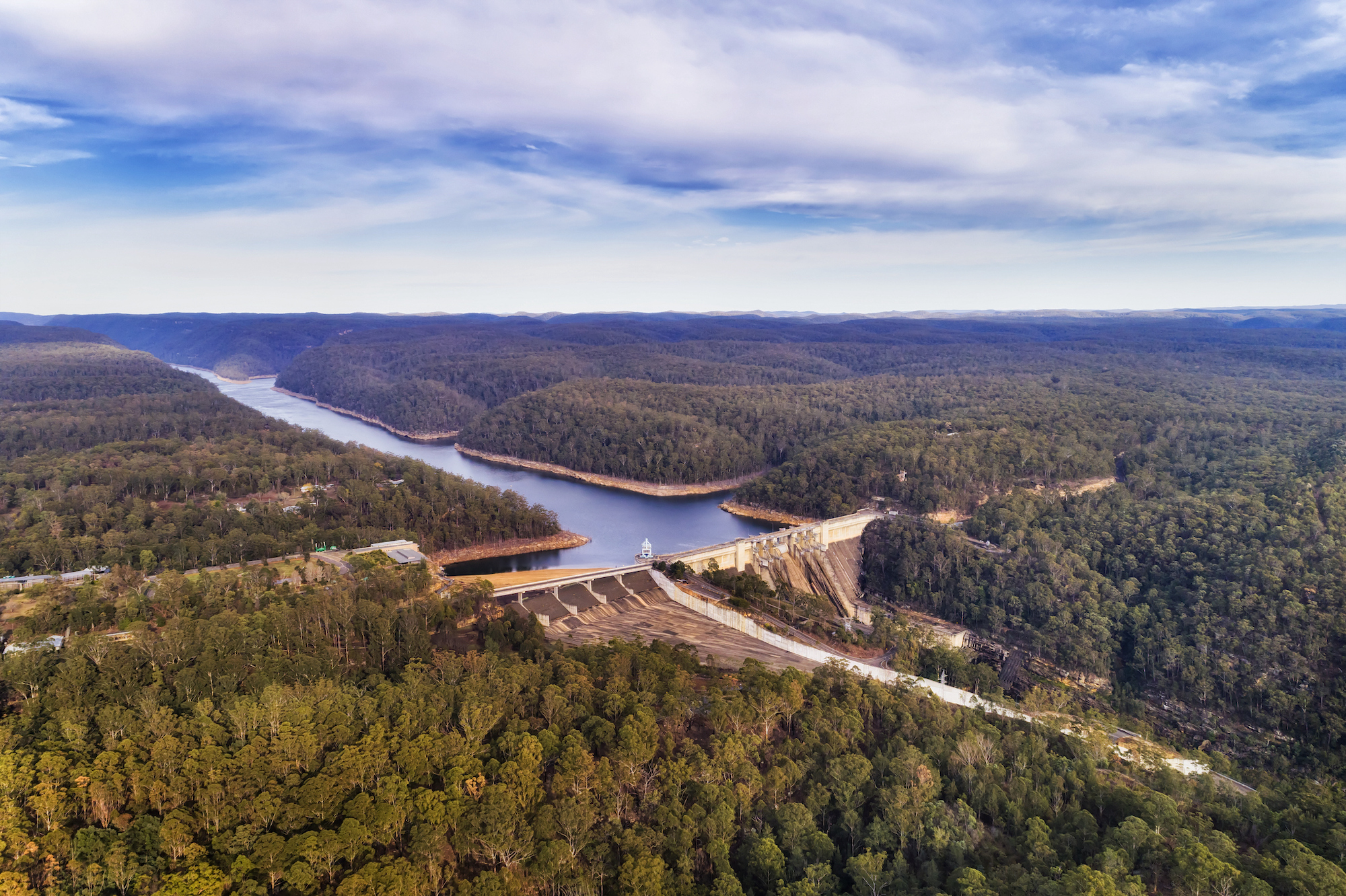
From boom to bust and back
Australians will remember the great fish cull that dominated news feed the summer of 2018-2019.
Talk of ‘big dams’ to ensure water security, and ‘unlock regions’ to increase agriculture, has started again with the proposed $5.4 billion Hells Gate Dam on the upper Burdekin River in Queensland, and the upgrade or replacement of Dungowan Dam, in the Peel River valley near Tamworth, New South Wales. So, what is it about dams and why are they staggeringly expensive? The damming of rivers to meet the water, energy and transport needs of humans is nothing new and has occurred at different scales for millennia. While ancient dams were small earthen walled structures, the modern versions are often concrete engineering behemoths.
The age of modern dam building peaked in the 1970s and has resulted in more than 50,000 dams of heights greater than 15 m controlling more than 15% of the world’s annual runoff and holding back more than 6,500 km3 of water. The history of dam building in Australia follows this global trend, with nearly all of Australia’s large dams constructed between 1950 and the early 1990s, consistent with global trends, and with no large dams completed after 1995. The construction slowdown reflects the reality that nearly all ‘suitable’ sites for large water storages are used. On the eastern coastal fringe most large water storages are used for urban water supply and hydropower, with some capacity for flood mitigation. West of the Great Dividing Range, dam infrastructure focuses less on water supply for urban settings and more on water supply for irrigated agriculture. This latter focus has proved particularly problematic for many regions over the last 20 years, with many water storages in the northern Murray-Darling Basin, for example, struggling to maintain water supply during the Millennium Drought, a situation likely to repeat as the climate becomes more variable.
Dams are environmentally catastrophic for rivers. Constructing a dam on a river completely changes all aspects of the river system; its flow regime, sediment transport dynamics and ecosystem processes, resulting in marked changes in biodiversity. As with nearly all river systems globally, and in Australia, impacted by dams (large and small) it is no wonder freshwater environments are the most threatened of all ecosystems; their continuous connection of upstream to downstream frequently fragmented by dams and other diversions. A dam causes both upstream and downstream impacts. Upstream, the once-flowing riverine environment is turned into a deep lake, a hostile environment for many riverine organisms. Downstream, the river is often ‘starved’ of its flow, artificially increasing the duration of low-flow conditions, a situation exacerbated by high amounts of water evaporated when water is stored in the reservoir area behind a dam. Dams trap sediment and nutrients and create an often-impassable barrier for many freshwater organisms. Research from across the globe demonstrates enormous environmental impacts from dam construction, including huge greenhouse gas emissions as methane is released from flooded areas. These impacts are legitimised by weightings towards the social and economic gains dam construction proports to make.

The Hells Gate Dam project proposes a 2,100 GL dam on the upper Burdekin River, 120 km northwest of Townsville. The rationale for the construction of the dam includes ensuring water security for north Queensland and opening up more than 60,000 hectares of land for irrigation. The Burdekin River basin covers 133,600 km2 of the northeast coast drainage division, 90% of the catchment is already used for agriculture, with surface water supporting a small irrigation industry dominated by sugarcane and horticulture. There are already two significant surface water storages within the Burdekin catchment; Lake Dalrymple which is formed by the Burdekin River Dam and Lake Eungella on the Broken River, a tributary to the Burdekin River. The Hells Gate Dam project would disrupt the current hydrological conditions in the Burdekin River, including its irrigation industry, by storing a portion of the water that currently flows down the Burdekin and into the Coral Sea, and turning it west into the upper catchments of the Flinders and Thomson Rivers.
Hells Gate Dam is one component of the controversial ‘Bradfield Scheme’ which has been debated for more than 80 years. Initially proposed in 1938, the Bradfield Scheme includes a system of pipes, tunnels, pumps and dams to divert river water from the tropical north across the Great Dividing Range into the rivers of inland Australia. The underlying premise of the Bradfield Scheme is that it would increase water security in northern Australia and support inland agricultural production. However, any analysis of the implementation of the Bradfield Scheme in its entirety has generally concluded that the economic costs of building the scheme far outweigh any benefits received in agricultural production, even without inclusion of the negative environmental outcomes of such a project. Although the Hells Gate Dam project proposes to feed water west using gravity, rather than the cost prohibitive option of pumping water over the Great Dividing Range, this will still require tunnels and pipes – expensive engineering options. Any water moved west of the Great Dividing Range moves into more semi-arid landscapes where a large proportion of natural flow is lost to evaporation or soaked up by floodplains and wetlands. In other words, the water diverted inland from the proposed Hells Gate Dam would need to be piped to exactly where it is needed or there would be gross losses in transit.
With climate variability increasing and water storages often reaching dangerously low levels it is often tempting to think that building more storages or increasing the volumes of current storages increases water security. There are, however, inherent problems in this logic. Our water storages are most vulnerable in times of drought – as seen by the exceptionally low levels of storage (<15%) in many of the dams of the northern Murray-Darling Basin in early 2020 after a period of the lowest rainfall on record. Drought is somewhat unpredictable, and often takes hold by stealth. Hydrological drought (reductions in river flow, and thus dam inflows) often lags meteorological drought (the reduction in rainfall). Often, by the time drought is officially declared, storages are less than 50% full. So, in a modern context we should not continue to rely on water held in storage for water security. Instead, we must turn attention to other options, including water recycling and desalination for coastal areas.
The debate around Hells Gate Dam, the Bradfield Scheme and other large dam projects will continue. In 2020 the Queensland Government commissioned an independent expert panel chaired by Professor Ross Garnaut, to investigate the viability of a modern Bradfield-like scheme. The outcomes of this investigation will be an important component in the emerging discussion around the viability of Hells Gate Dam. We should, however, also learn from past projects; the Ord River irrigation scheme was another project designed to enhance water security and expand irrigation in northwest Western Australia, however, despite a cost of $2 billion, the project supports just 260 jobs, and the unique riverine ecosystem of the Ord River has been changed forever (a cost that is never included). Globally, the United Nations now recommends that dam construction places environmental and social factors on an equal footing with more traditional technical, economic and financial factors, and recommends full participation of stakeholders to increase transparency. As river scientists we hope that these new discussions on dam building can incorporate an ecosystem lens.

Dr Fran Sheldon is Professor and Dean (Learning and Teaching) in the Griffith Sciences group at Griffith University and a Research Member in the Australian Rivers Institute. Her research explores the relationships between hydrology, physical geomorphology and ecology in river systems, particularly large dryland rivers such as those of the Murray-Darling Basin and the Lake Eyre Basin.

David Hamilton is the Deputy Director and a Professor in the Australian Rivers Institute, Griffith University. He has held positions in Environmental Engineering at the University of Western Australia and Biological Sciences at the University of Waikato in New Zealand. He was appointed as the inaugural Bay of Plenty Regional Council Chair in Lake Restoration at the University of Waikato in 2002 and held this position for 15 years, until his current appointment. His research has involved testing and modelling of lake restoration actions and more generally, documenting the restoration and recovery of freshwater ecosystems. In recent years he has been closely involved in management and policy implementation for freshwater ecosystems, holding appointments with the Ministry for the Environment (NZ) and advisory roles for regional councils and industry groups in New Zealand and Australia.

Australians will remember the great fish cull that dominated news feed the summer of 2018-2019.

Hosting a major or even mega-sporting event like the Olympic and Paralympic Games is regarded by many as a great honour for the host city. But it presents some major challenges as well: How does Brisbane integrate infrastructure, create precincts while limiting legacy impacts.

We are entering a uniquely dangerous time in Australian politics Not just from the economic threats following Australia’s performance at COP26 in Glasgow. Compounding these existential threats is the risk that core tenets of Australian democracy, which have become weakened and frayed in the past two decades, will be completely eroded.